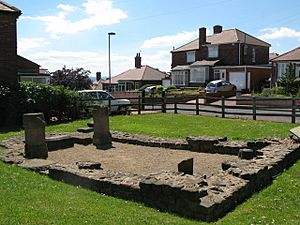Antenociticus facts for kids
Antenociticus was a local god worshipped during the Romano-British period. This means he was important to people living in Britain when the Romans ruled. His name was also sometimes written as "Anociticus." People believed he could give soldiers courage and help them in battles.
Contents
Discovering Antenociticus
The Temple at Benwell Fort
Antenociticus was worshipped at only one known place in Britain. This was at a Roman fort called Condercum, which is now known as Benwell. Benwell is located on Hadrian's Wall, a famous wall built by the Romans.
Archaeologists found three altars dedicated to Antenociticus inside a small temple at Benwell. An altar is a special stone used for offerings to a god. Because Antenociticus is not mentioned on any Roman altars found outside Britain, experts believe he was a local British god, not one brought over by the Romans.
Important Roman military leaders worshipped Antenociticus at Benwell. These included a `legate` (a high-ranking army commander), a `tribune` (a military officer), and a `prefect` (another type of commander). The fact that such important Romans worshipped him here suggests he was a local god, not just a god brought by a specific Roman army group.
The Statue of Antenociticus
In 1862, parts of a statue of Antenociticus were found at the temple in Benwell. The most important find was the sandstone head of the god. It shows him wearing a `torc` (a metal neck ring) around his neck. His hair curls forward, looking a bit like two horns. Pieces of the statue's lower leg and forearm were also found. This tells us that a life-sized statue of Antenociticus once stood in his temple.
The Temple's Location and Purpose
The small temple of Antenociticus was built in the `vicus`, which was a civilian settlement just outside the Benwell Fort. Benwell was one of 13 permanent forts built along Hadrian's Wall. The temple was likely built around AD 178-180. It might have been built to celebrate the promotion of a Roman cavalry prefect who dedicated one of the altars to Antenociticus. As mentioned, people thought Antenociticus helped with military matters, giving inspiration and support.
Antenociticus is unique because he is not mentioned at any other Roman-British site or on any inscriptions from other parts of the Roman Empire. This strongly suggests he was a local god, important only in this specific area of Britain.
Where to See the Discoveries Today
The head of Antenociticus and the altars from his temple were once displayed at the Museum of Antiquities at Newcastle University. Now, you can see these important historical items at the Great North Museum in Newcastle.
Another Possible Discovery
In 2013, archaeologists found a similar sandstone head at Binchester Roman Fort, near Bishop Auckland. Some experts think this head might also be of Antenociticus.


